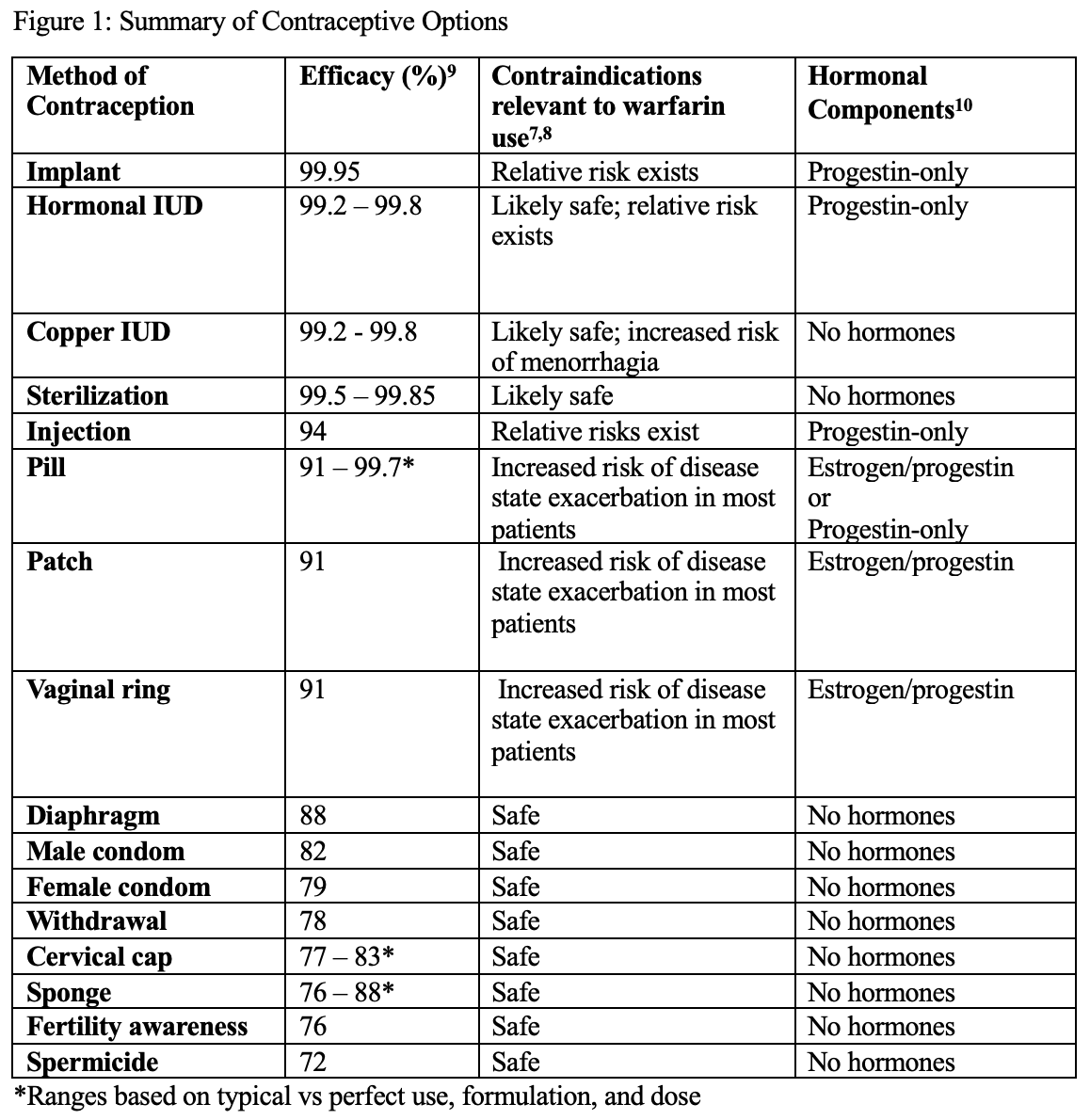Commentary
Article
Pharmacists Assist with Family Planning in Warfarin Patients
Author(s):
In most patients who are pregnant or may become pregnant, warfarin is contraindicated due to increased risk of adverse fetal outcomes.
Warfarin (Jantoven; United Research Labs) is an anticoagulant commonly used for the prophylaxis and treatment of venous thromboembolism (VTE) as well as thromboembolic complications associated with atrial fibrillation and/or cardiac valve replacement.1 The use of warfarin is contraindicated in pregnancy except in certain cases for women with mechanical heart valves at high risk for thromboembolism.
Pregnancy status should be evaluated prior to the use of warfarin in patients who may become pregnant. Patients who may become pregnant should use effective contraception during warfarin therapy and for 1 month after the last dose. Both pharmacologic and nonpharmacologic methods of contraception are available for women of child-bearing potential and pharmacists can play a key role in assisting with family planning in patients on warfarin therapy.
Image credit: pressmaster - stock.adobe.com

In most patients who are pregnant or may become pregnant, warfarin is contraindicated due to increased risk of adverse fetal outcomes.1 The FDA lists warfarin as category X with a labeled contraindication in pregnancy based on case data of fetal harm.2 Warfarin crosses the placenta and, therefore, concentrations in the fetal plasma are similar to maternal values. When warfarin is given during the first trimester—particularly between the sixth and ninth weeks of pregnancy—a constellation of birth defects known as fetal warfarin syndrome (FWS) can occur. FWS is characterized mainly by skeletal abnormalities, including nasal hypoplasia, a depressed or narrowed nasal bridge, scoliosis, limb abnormalities, and underdeveloped extremities. Other common features of FWS include low birth weight and developmental disabilities. Although the highest risk of fetal harm has been reported with warfarin use during the first trimester of pregnancy, central nervous system disorders, including spasticity, seizures, and eye defects, have also been observed following warfarin exposure during any trimester.
Although warfarin is contraindicated during pregnancy, the potential benefits of using warfarin may outweigh the risks in specific cases for pregnant women with mechanical heart valves at high risk of thromboembolism.3,4 In this particular situation, the decision to initiate or continue warfarin should be discussed with the patient and a high risk obstetrician; taking into consideration the specific risks and benefits, as well as the most current recommendation from ACC/AHA guidelines for management of patients with valvular disease and The American College of Obstetricians and Gynecologists (ACOG) guidelines.1 Adjusted-dose low molecular weight heparin (LMWH) or adjusted-dose unfractionated heparin (UFH) may be used in women with mechanical heart valves as well. Regardless of therapeutic plan, patients that become pregnant with a mechanical heart valve should be monitored closely due to increased risk of thromboembolism and potential incurred risks from medical management.
Patients considering pregnancy while on warfarin should be referred to a high-risk obstetrician and warfarin should be discontinued at least 4 weeks prior to conception to avoid maternal or fetal complications.1 The American College of Chest Physicians recommends use of LMWH, such as enoxaparin, for the prevention and treatment of venous thromboembolism (VTE) in pregnant women.3,6 ACOG also recommends anticoagulation with LMWH or UFH for most patients requiring prophylactic or treatment dose anticoagulation during pregnancy; regardless of indication for anticoagulation.5 Although LMWH is the preferred agent during pregnancy, ACOG recommends transitioning to UFH at 36 weeks’ gestation to minimize risk of bleeding or anesthesia complications during labor.
Postpartum, warfarin is a first line agent for anticoagulation for all indications per ACOG.5 Patients on UFH or LMWH can be bridged to therapeutic INR for warfarin after delivery. Based on available data, warfarin is not present in breast milk and is therefore also recommended as a first-line agent in women who are breastfeeding. Since warfarin is a high-risk medication, as a safety precaution, women and breastfed babies should be monitored for increased signs of bruising or bleeding during therapy.
For women of childbearing potential on warfarin therapy who wish to prevent or delay pregnancy, several options exist for contraception. Method(s) should be selected based on patient preference, effectiveness, need for sexually transmitted infection prevention, adverse effects, and contraindications. Based on the indication for warfarin, the risk of disease state exacerbation may outweigh the benefit of using certain methods of contraception. For example, in patients with a past medical history of VTE, the CDC recommends avoiding combined oral contraceptives (COCs) as the estrogen component may pose an increased risk for disease state exacerbation or recurrence.7
In addition, it is also recommended to avoid COCs in patients with a history of valvular heart disease or stroke. Progestin-only contraception such as the pill, injection, or implant may carry theoretical or proven risks that usually outweigh benefits of use in patients with a previous stroke and therefore should not be recommended. Patients should also be screened for other health conditions that may affect their eligibility for different contraceptive options, including history of migraine with aura, breast cancer, and chronic health conditions as per CDC criteria for medical eligibility for contraception.7
Options that are likely safe and efficacious in patients that are taking warfarin, regardless of indication, include copper or hormonal intrauterine devices (IUDs) and nonpharmacologic options. Due to localized action of IUDs and lower systemic hormone absorption than oral or implanted contraceptives, risks seen with IUD use are lower.8 There is also a lower or nonexistent risk of drug-drug interactions when using an IUD, when compared to oral contraception.
Oral contraceptive options containing progestin or estrogen may interact with warfarin and variably increase or decrease INR.1 Use of emergency contraception such as levonorgestrel may also variably interact with warfarin and cause a change in INR. Copper IUDs may be inserted as a form of emergency contraception if needed to avoid drug-drug interactions. However, copper IUDs may increase risk of menorrhagia, especially in patients taking warfarin.
Additionally, nonpharmacologic forms of contraception including male condoms, diaphragms, female condoms, cervical caps, and sponges may be used.7 These options may be preferred in patients wishing to avoid hormonal medication, who are contraindicated for use of hormonal options, or who are unable to maintain a therapeutic INR due to drug-drug interactions of contraception with warfarin.
If patients become pregnant unintentionally while on warfarin therapy, warfarin should be discontinued immediately upon positive pregnancy test and UFH or LMWH should be initiated. Patients should be counseled on the potential of fetal harm, based on gestational age at time of positive pregnancy test. Fetal harm may have occurred prior to positive pregnancy test and be undetectable until birth. Patients can be counseled on risks and benefits of choosing to continue with pregnancy based on current state law and accessibility of medical termination. Patients should be referred to a high-risk obstetric physician for termination or management of pregnancy.
According to ACOG, the most effective birth control methods include the implant (99.95% effective), IUD (99.2-99.8% effective), and sterilization (99.5-99.85% effective), with less than 1 pregnancy per 100 women in a year. IUD or sterilization should be recommended first for patients requiring long term warfarin therapy due to efficacy, absence of estrogen, and minimal need for adherence. The injection (94% effective), pill (91% effective), patch (91% effective), vaginal ring (91% effective), and diaphragm (88% effective) are the next most effective methods, with 6 to 12 pregnancies per 100 women in a year.8 The need for strict adherence also begins to increase in patients using COCs as efficacy is highly affected by typical use (91% effective) versus perfect use (99.7%). The least effective methods of contraception include the male condom (82% effective), female condom (79% effective), withdrawal method (78% effective), cervical cap (77% to 83% effective), sponge (76% to 88% effective), fertility awareness-based methods (76% effective), and spermicide (72% effective), with 18 or more pregnancies per 100 women in a year.9
Patient-centered decision making is imperative in appropriately managing patients of child-bearing potential on warfarin therapy. Most recommendations regarding warfarin use in pregnant women are based on observational studies and extrapolation from other populations. Although there is an urgent need for appropriately designed studies in this population, ethical concerns will likely hinder many research efforts. Prior to initiation and throughout warfarin therapy, counseling should be provided to all patients of child-bearing potential on the importance of effective contraception.

Pharmacists can recommend plans for pregnancy prevention to avoid any unwanted adverse complications. Additionally, pre-planning can be done for pregnancy, to allow for the safest transition and best opportunity for shared decision making for future planned pregnancies. Pharmacists are in a great position to provide education to this patient population, which may decrease the risk of permanent and life threatening maternal and fetal complications.
References
1. Coumadin. Package insert. Bristol-Myers Squibb Company. 2010. https://www.accessdata.fda.gov/drugsatfda_docs/label/2010/009218s108lbl.pdf
2. Yarrington CD, Valente AM, Economy KE. Cardiovascular management in pregnancy. Circulation. 2015;132:1354–1364. doi:10.1161/CIRCULATIONAHA.114.003902
3. Otto CM, Nishimura RA, Bonow RO, et al. 2020 ACC/AHA Guideline for the management of patients with valvular heart disease: a report of the American college of cardiology/American heart association joint committee on clinical practice guidelines. Circulation. 2021;143:e72–e227. doi:10.1161
4. Ahmed Hassouna, Hemat Allam. Limited dose warfarin throughout pregnancy in patients with mechanical heart valve prosthesis: a meta-analysis. Interact Cardiovasc Thorac Surg. 2014;18,(6):797–806. doi:10.1093/icvts/ivu009
5. ACOG Practice Bulletin No. 196: Thromboembolism in Pregnancy. Obstetrics & Gynecology. 2018:132(1):e1-e17. doi:10.1097/AOG.0000000000002706
6. Bates SM, Greer IA, Middeldorp S, Veenstra DL, Prabulos AM, Vandvik PO. VTE, thrombophilia, antithrombotic therapy, and pregnancy: Antithrombotic Therapy and Prevention of Thrombosis, 9th ed: American College of Chest Physicians Evidence-Based Clinical Practice Guidelines. Chest. 2012;141(2 Suppl):e691S-e736S. doi:10.1378/chest.11-2300.
7. CDC. Summary chart of U.S. medical eligibility criteria for contraceptive use. Updated 2020. Accessed November 1, 2023. https://www.cdc.gov/reproductivehealth/contraception/pdf/summary-chart-us-medical-eligibility-criteria_508tagged.pdf
8. Mirena. Package insert. Bayer healthcare pharmaceuticals. 2008. https://www.accessdata.fda.gov/drugsatfda_docs/label/2008/021225s019lbl.pdf
9. ACOG. Effectiveness of birth control methods. https://www.acog.org/-/media/project/acog/acogorg/womens-health/files/infographics/effectiveness-of-birth-control-methods.pdf
10. Centers for disease control and prevention. Birth Control Methods. 2023 https://www.cdc.gov/reproductivehealth/contraception/index.htm
Newsletter
Stay informed on drug updates, treatment guidelines, and pharmacy practice trends—subscribe to Pharmacy Times for weekly clinical insights.






